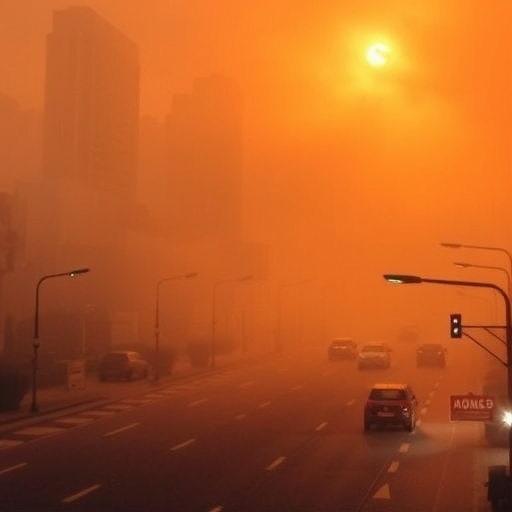In recent years, air quality has emerged as one of the most pressing environmental and health issues globally, particularly in urban areas. A groundbreaking study by Vuong, Thang, and Linh sheds light on the levels of fine particulate matter in two of Vietnam’s most populous cities, Ho Chi Minh City and Hanoi, over a four-year period from 2016 to 2020. This research not only provides valuable insights into pollution trends but also serves as a wake-up call for policy makers and citizens alike regarding the deteriorating air quality standards.
Fine particulate matter, often referred to as PM2.5, is a category of tiny particles that can penetrate deep into the respiratory system, posing serious health risks such as cardiovascular diseases, respiratory infections, and even premature death. With the rapid industrialization and urbanization that Vietnam has experienced, understanding the sources and concentrations of PM2.5 has become paramount for public health initiatives. The authors of the study utilized a combination of ground-based measurements and satellite data to present a comprehensive view of fine particulate matter trends over the studied years.
The research reveals alarming statistics: both Ho Chi Minh City and Hanoi exhibited consistently high levels of PM2.5 that often exceeded the World Health Organization’s recommended guidelines. The study indicates that the average PM2.5 concentration in these cities not only fluctuated but was influenced by various factors including traffic emissions, industrial activities, and seasonal weather variations. A key finding from the research highlights during specific months, especially those when local agricultural burning is common, PM2.5 concentrations spiked significantly, further exacerbating the health risks to residents.
In addition to assessing the airborne particles through measurements, the authors conducted an analysis of potential sources contributing to the pollution. Transportation emerged as a significant contributor, with vehicular emissions being a predominant factor in urban areas. The study also analyzed industrial emissions, particularly from coal-fired power plants, which released substantial quantities of particulates into the atmosphere, adding to the existing burdens. This correlation marks a critical link that advocates for enhanced regulatory measures targeting both vehicle emissions and industrial output.
A significant aspect of the study is its focus on public health implications. Vietnam’s swift economic growth, while beneficial in many regards, has come at the cost of air quality, which can result in long-term health complications for a large portion of the population. The authors detail the potential health outcomes associated with sustained exposure to high PM2.5 levels, including the increased prevalence of respiratory diseases among children and the elderly. As such, this research could be a catalyst for concerted actions aimed at improving air quality.
Moreover, the authors urge for increased public awareness about air quality and its impacts. It has become imperative for citizens to be informed about the air they breathe and the inherent risks associated with pollution. The study suggests implementing community outreach programs focusing on educating the public about PM2.5, its effects, and preventive measures they can take. With knowledge, the community can begin to take proactive steps toward reducing their exposure and advocating for better air quality measures.
The researchers also emphasize the need for governmental policies that prioritize air quality regulation. They underscore the importance of enforcing stricter emission limits for vehicles and factories, as well as promoting public transportation solutions to decrease individual car usage. The study presents a strong case for investing in clean technologies that can assist in reducing emissions and improving air quality in the long term.
In addition to local policy changes, the research supports the idea of international collaborations in combating air pollution. As air quality does not recognize borders, sharing knowledge, technology, and best practices between nations can lead to more effective strategies in managing air pollution. The authors highlight successful international programs that have proven effective in other regions and suggest similar initiatives could be adopted in Vietnam.
Looking towards the future, the authors advocate for further research into the long-term trends of air quality in Vietnam, taking into consideration the rapid urbanization and its looming effects. The collection of long-term data can provide insight into the effectiveness of policies implemented and help in strategizing future legislative actions. With continual monitoring, it will be easier to identify pollution sources and target them effectively.
Finally, the researchers stress that community involvement is crucial for any long-lasting change. Citizen engagement, whether through local clean-up initiatives or participation in air quality monitoring, can cultivate a culture of environmental responsibility. This grassroots involvement encourages individuals to become stewards of their environment, inspiring collective action towards cleaner air.
In summary, the research conducted by Vuong, Thang, and Linh represents a pivotal moment for understanding air quality issues in major Vietnamese urban areas. It underscores the multitude of health and environmental impacts tied to PM2.5 levels and calls for urgent action from policymakers and the community alike. The extensive insights provided not only enhance the scientific discourse but also serve to mobilize efforts to combat air pollution more effectively in Vietnam.
In closing, the situation in urban Vietnam is a microcosm of the wider global struggle against air pollution, marking the need for immediate and sustained action. The burden of dirty air is one that all nations must confront, and the findings of this study could serve as a critical blueprint for actions both in Vietnam and beyond.
Subject of Research: Levels of fine particulate matter (PM2.5) in Vietnam’s two largest cities.
Article Title: Insight into the levels of fine particulate matter during 2016–2020 in the two largest cities of Vietnam.
Article References: Vuong, Q.T., Thang, P.Q. & Linh, L.V. Insight into the levels of fine particulate matter during 2016–2020 in the two largest cities of Vietnam. Environ Monit Assess 197, 1322 (2025). https://doi.org/10.1007/s10661-025-14765-1
Image Credits: AI Generated
DOI: https://doi.org/10.1007/s10661-025-14765-1
Keywords: air quality, fine particulate matter, PM2.5, Vietnam, public health, pollution trends.




